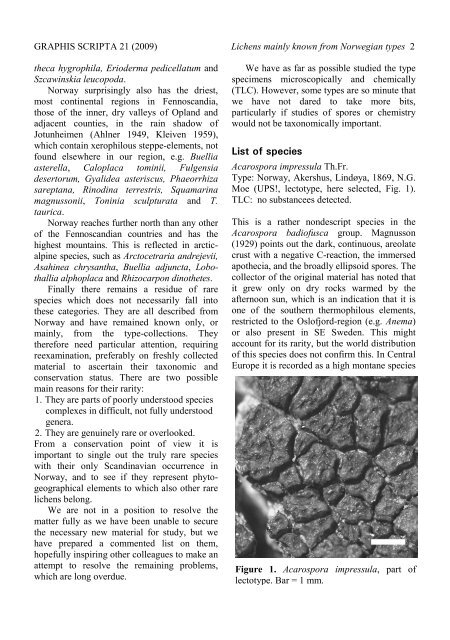(2009): Lichens in Scandinavia known mainly from Norwegian type ...
(2009): Lichens in Scandinavia known mainly from Norwegian type ...
(2009): Lichens in Scandinavia known mainly from Norwegian type ...
Create successful ePaper yourself
Turn your PDF publications into a flip-book with our unique Google optimized e-Paper software.
GRAPHIS SCRIPTA 21 (<strong>2009</strong>) <strong>Lichens</strong> ma<strong>in</strong>ly <strong>known</strong> <strong>from</strong> <strong>Norwegian</strong> <strong>type</strong>s 2<br />
theca hygrophila, Erioderma pedicellatum and<br />
Szcaw<strong>in</strong>skia leucopoda.<br />
Norway surpris<strong>in</strong>gly also has the driest,<br />
most cont<strong>in</strong>ental regions <strong>in</strong> Fennoscandia,<br />
those of the <strong>in</strong>ner, dry valleys of Opland and<br />
adjacent counties, <strong>in</strong> the ra<strong>in</strong> shadow of<br />
Jotunheimen (Ahlner 1949, Kleiven 1959),<br />
which conta<strong>in</strong> xerophilous steppe-elements, not<br />
found elsewhere <strong>in</strong> our region, e.g. Buellia<br />
asterella, Caloplaca tom<strong>in</strong>ii, Fulgensia<br />
desertorum, Gyalidea asteriscus, Phaeorrhiza<br />
sareptana, R<strong>in</strong>od<strong>in</strong>a terrestris, Squamar<strong>in</strong>a<br />
magnussonii, Ton<strong>in</strong>ia sculpturata and T.<br />
taurica.<br />
Norway reaches further north than any other<br />
of the Fennoscandian countries and has the<br />
highest mounta<strong>in</strong>s. This is reflected <strong>in</strong> arcticalp<strong>in</strong>e<br />
species, such as Arctocetraria andrejevii,<br />
Asah<strong>in</strong>ea chrysantha, Buellia adjuncta, Lobothallia<br />
alphoplaca and Rhizocarpon d<strong>in</strong>othetes.<br />
F<strong>in</strong>ally there rema<strong>in</strong>s a residue of rare<br />
species which does not necessarily fall <strong>in</strong>to<br />
these categories. They are all described <strong>from</strong><br />
Norway and have rema<strong>in</strong>ed <strong>known</strong> only, or<br />
ma<strong>in</strong>ly, <strong>from</strong> the <strong>type</strong>-collections. They<br />
therefore need particular attention, requir<strong>in</strong>g<br />
reexam<strong>in</strong>ation, preferably on freshly collected<br />
material to ascerta<strong>in</strong> their taxonomic and<br />
conservation status. There are two possible<br />
ma<strong>in</strong> reasons for their rarity:<br />
1. They are parts of poorly understood species<br />
complexes <strong>in</strong> difficult, not fully understood<br />
genera.<br />
2. They are genu<strong>in</strong>ely rare or overlooked.<br />
From a conservation po<strong>in</strong>t of view it is<br />
important to s<strong>in</strong>gle out the truly rare species<br />
with their only Scand<strong>in</strong>avian occurrence <strong>in</strong><br />
Norway, and to see if they represent phytogeographical<br />
elements to which also other rare<br />
lichens belong.<br />
We are not <strong>in</strong> a position to resolve the<br />
matter fully as we have been unable to secure<br />
the necessary new material for study, but we<br />
have prepared a commented list on them,<br />
hopefully <strong>in</strong>spir<strong>in</strong>g other colleagues to make an<br />
attempt to resolve the rema<strong>in</strong><strong>in</strong>g problems,<br />
which are long overdue.<br />
We have as far as possible studied the <strong>type</strong><br />
specimens microscopically and chemically<br />
(TLC). However, some <strong>type</strong>s are so m<strong>in</strong>ute that<br />
we have not dared to take more bits,<br />
particularly if studies of spores or chemistry<br />
would not be taxonomically important.<br />
List of species<br />
Acarospora impressula Th.Fr.<br />
Type: Norway, Akershus, L<strong>in</strong>døya, 1869, N.G.<br />
Moe (UPS!, lecto<strong>type</strong>, here selected, Fig. 1).<br />
TLC: no substancees detected.<br />
This is a rather nondescript species <strong>in</strong> the<br />
Acarospora badiofusca group. Magnusson<br />
(1929) po<strong>in</strong>ts out the dark, cont<strong>in</strong>uous, areolate<br />
crust with a negative C-reaction, the immersed<br />
apothecia, and the broadly ellipsoid spores. The<br />
collector of the orig<strong>in</strong>al material has noted that<br />
it grew only on dry rocks warmed by the<br />
afternoon sun, which is an <strong>in</strong>dication that it is<br />
one of the southern thermophilous elements,<br />
restricted to the Oslofjord-region (e.g. Anema)<br />
or also present <strong>in</strong> SE Sweden. This might<br />
account for its rarity, but the world distribution<br />
of this species does not confirm this. In Central<br />
Europe it is recorded as a high montane species<br />
Figure 1. Acarospora impressula, part of<br />
lecto<strong>type</strong>. Bar = 1 mm.

















